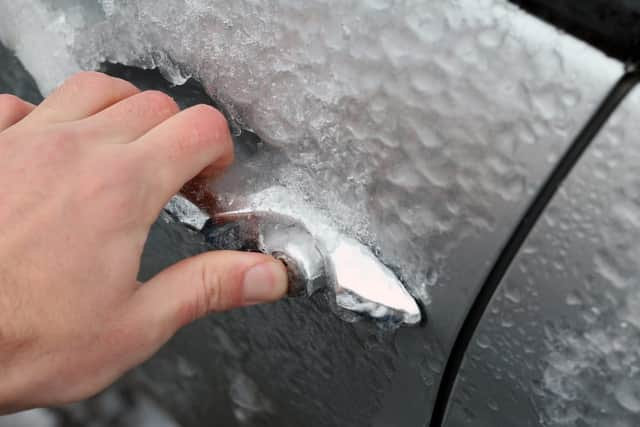Frozen car door: what to do if your car door or lock is frozen shut - and how to open it without causing damage


It’s bad enough coming out in the morning to find your windscreen iced over but even more inconvenient is finding your car’s doors frozen shut.
Sometimes the problem is a frozen handle, sometimes the rubber door seal is frozen to the bodywork and sometimes ice is holding the metal of the door to another part of the car.
Advertisement
Hide AdAdvertisement
Hide AdThe solutions depend on the problem but the first piece of advice applies to all situations - don’t just keep yanking at the handle in the hope that it’ll free things off.
This could just add a broken handle or internal mechanism to your list of problems. Alternatively, it might open the door but leave the rubber seal torn and damaged.


Try another door
The quickest option is to try another door. Depending on the positioning of your car, one side might be more sheltered or more exposed to sunlight, making it less likely to be frozen. If you can get in another way, climb over, start the engine and get the fans going - the warm air inside will help thaw the frozen door.
Push, don’t pull
A firm shove might be enough to crack any thin ice holding a door shut. Put your hand flat against the door and lean with your body - you want a firm push, not a sudden slam.
Scrape off surface ice
Advertisement
Hide AdAdvertisement
Hide AdIf it’s just a stuck handle, chipping the ice off with a scraper should do the trick. If the problem is ice all around the edge of the door then work slowly and remove as much of it as you can then try the push-then-pull technique.
Warm water
Pouring some lukewarm - never boiling - water around the affected area can help melt the ice that’s causing the handle, door or seal to stick. Make sure the water isn’t too hot and once you’ve got the door open be sure to dry down any wet surfaces to avoid more ice forming.


De-icer
Chemical de-icer is usually sold as a way to clear windscreens but it can also help with a stuck door or lock. The chemicals will help break down the ice stopping the door from opening whether that’s on the handle, the bodywork or the rubber seal.
Stuck lock
If you need to use a key to open your car and the lock is iced over there are a couple of techniques to try.


Advertisement
Hide AdAdvertisement
Hide AdThe first is a quick spray of de-icer over the surface and into the lock. You can buy special cans with a straw for this purpose but any de-icer spray will do. Try not to get too much on the bodywork as the chemicals can damage some paint.
Try heating the metal part of the key with a match or lighter. It’s not an ideal solution but if you must then don’t overheat it - warm to the touch is fine - and make sure you keep the flame away from any plastic or electronic parts.
If you don’t have either to hand then you can try blowing warm air over the lock - just be prepared for it to take a while and do try not to get your lips stuck to the cold metal.
How to stop your car door or lock from freezing
You can’t stop the cold but you can reduce the chance of your doors sticking.
Advertisement
Hide AdAdvertisement
Hide AdThe easiest way is to park your car somewhere sheltered like a garage or carport. If that’s not an option, a car cover can provide enough protection to stop your car icing up.
Alternatively, to stop a rubber seal freezing and sticking you can apply a lubricant such as a silicon lubricant or petroleum jelly (Vaseline, for example) to it. Obviously, don’t use water as a lubricant and avoid oil-based options as these can be bad for the rubber.
Similarly, put a little petroleum jelly or rubbing alcohol (a decent high-alcohol hand sanitiser will do) on the key and put it in the lock while it is defrosted. This will leave a coating inside the lock which can be enough to prevent it freezing in future.
